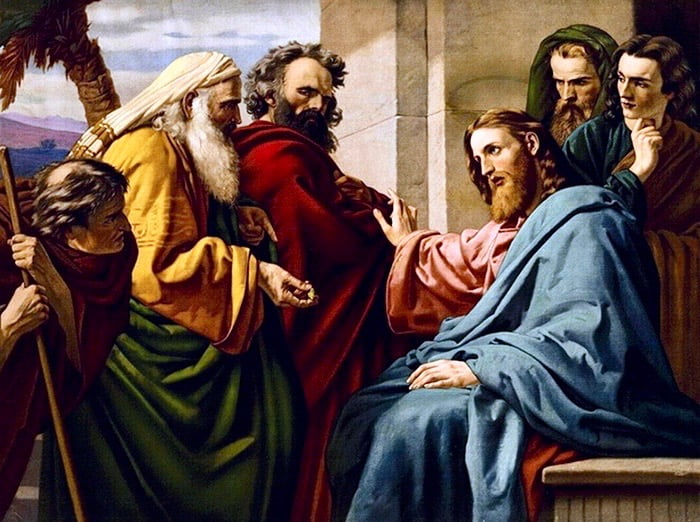If you’re like me–after having read Mark 2:18-22–you’re wondering what all the hubbub is about fasting. Using commentaries can be helpful (and challenging!), but there are basic steps any of us can more fully read and understand Scripture for ourselves, simply by paying attention to literary contexts and structures.
It begins with reading for comprehension, which helps us grasp what the text says. We do this by getting familiar with the context of the passage, defining words, noting the structure of the text, and picking out the details. Then we can move into interpretation, which tells us what the text means. We do this by looking up cross-references and summarizing the text in our own words before asking others to do our thinking for us. After all our efforts, we can supplement our understanding with other voices and sources.
Comprehension of Mark 2:18-22
Context is always key. Because we’ve read the preceding chapter and verses, we know that our setting is first-century Israel when God’s people are under Roman rule–oppressed, taxed, and under threat of losing their way of life. We also know that Jesus has arrived on the scene and, with His new disciples, travels across Galilee with a new message, the Good News.
Defining words and phrases clarify our characters and conflicts:
- John’s disciples (v.18) – If we aren’t clear on who John is, we have to read back in the text to uncover that detail. In Mark 1:4-8, we find this is John the Baptist.
- Pharisees (v.18) – We can search our Bible’s glossary or look online to learn they were one the leading sects within the Jewish faith who strictly obeyed God’s Law as well as those created by Jewish leaders. Pharisees began as a lay movement about 150 years earlier as a way to resist outside cultural influences–like the Romans. Their strict adherence to the Law was their way to maintain religious and cultural purity.
- Fasting (v.18) – Today, this spiritual discipline usually means abstaining from food as a way to better focus on God. But fasting in Jesus’ day is mostly for the purpose of mourning. In fact, the Law requires fasting only one day a year, the Day of Atonement (Lev. 16:29-30).
- Bridegroom (v.19) – a man who’s set to be married. In this passage there is no wedding. Jesus is not getting married, so this word becomes a clue that Jesus is sharing a parable, a story used to illustrate a spiritual truth.
- Wineskin (v.22) – an animal skin used to hold wine. Wineskins that are deemed “old” have been stretched to their limit, becoming cracked.
Next, we look to see how our passage fits into the greater structure of the passages around it. Headings in our Bibles help give clues, as do similar or repetitive conversations, which is the case for us. Curious, I checked a commentary to learn more about its structure. We can “zoom out” to see Mark 2:1-3:6 as a whole to find five stories of controversy put in a “chiastic” structure:
A–Healing (the paralytic)
B–Controversy (over ritual law, eating with unclean people)
C–Dispute over fasting
B–Controversy (over Sabbath law)
A–Healing (the man with withered hand)
Our focus, 2:18-22, falls right in the middle–the dispute over fasting–and, as such, provides a contrast of old and new, helping us see that each of these parables serve as an illustration to the new ways Christ ushers in, which invites all sorts of opposition for Jesus (Harper’s Bible Commentary).
Interpretation of Mark 2:18-22
Now, we “zoom in” for details, which we’ll interweave with interpretation. Keeping in mind how the Pharisees question why Jesus’ disciples don’t fast according to their ways (v.18) helps us move forward with focus.
Knowing that the Law only requires fasting for mourning raises a question because the Pharisees seem to be expecting a different kind of fast. With some cross-referencing to other passages, we discover that the Pharisees fast two days a week (Luke 18:12). Some commentators speculate that this particular day–the disciples’ feast with Jesus–coincides with one of those Pharisaic fasting days. When we put all this together, we can see how the contrast of Jesus’ feasting with their fasting adds fuel to their criticisms of Jesus.
Rather than responding to their questions, Jesus offers a parable about a bridegroom, setting Himself up as the One who should be celebrated while He’s present and mourned when He leaves. Those hearing Jesus’ words would not know the ending of the story as we do. So, Jesus’ pronouncement would have been startling at best. Blasphemous at worst–because when Jesus describes Himself as the bridegroom, He elicits Old Testament imagery of God as the bridegroom (Hosea 2:16-20). As a result, the Pharisees react strongly against His self-described divinity.
Jesus doesn’t stop there, however. He emphasizes the significance of Himself as the bridegroom with two metaphors in order to help listeners understand His teachings are new and won’t fit with the old ways–just as a new patch tears old fabric and new wine bursts old wineskin.
Mark, our author, intentionally places this dispute at the center of this chiastic section because of its pivotal importance to the underlying message of Jesus’ rejection of old, legalistic religion, especially when it hurts people who are already suffering, as we see in the other stories.
The Big “So What”
It turns out that all the hubbub about fasting is less about fasting and more about Jesus’ introduction of a new way of living. And, just like that old wineskin, the Pharisees’ old ways of living bound by the Law are too brittle to adapt to Jesus’ new ways.
The final step in reading a passage for ourselves is application, which gives us space to ask, “What does this mean for me?” However, there is most often a corporate aspect to Scripture that we tend to overlook. Perhaps, the question we should be asking is, “What does this mean for us?”
